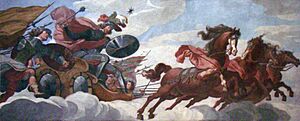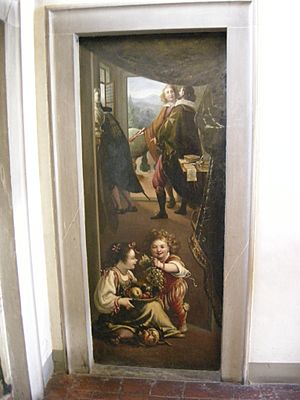Luigi Baccio del Bianco facts for kids
Luigi Baccio del Bianco (born October 31, 1604 – died July 1657) was a talented Italian artist. He worked as an architect, engineer, and painter. He was also a scenic designer, creating amazing backgrounds and props for plays and shows.
Contents
Early Life and Training
Baccio del Bianco was born in Florence, Italy. His father, Cosimo del Bianco, sold special fabrics to rich families. These fabrics were used for big parties, knight tournaments, and theater shows.
From 1612 to 1620, Baccio studied painting with a famous artist named Giovanni Bilivert. He also learned from Giulio Parigi. Baccio was also inspired by Vincenzio Bocaccio from Rome, who was a great student of the architect and painter Lodovico Cigoli.
Travels and Important Projects
Baccio del Bianco traveled a lot for his work. He created beautiful art and designs in many different cities.
Working in Central Europe
In 1620, Baccio traveled to a region called Germania, which included parts of modern-day Slovakia. There, he helped Giovanni de Galliano Pieroni build a strong fortress in Bratislava.
After this, he returned home and decorated many houses. He also painted for churches and theaters. In 1622, he went to Vienna, and then to Prague. In Prague, he did a lot of fresco painting in the grand Wallenstein Palace. Frescoes are paintings made directly onto wet plaster walls. He painted in the Audience Hall, St. Wenceslas Chapel, and other areas. He sometimes had helpers for these big projects.
Baccio did not stay in Prague permanently. Records show he lived in Milan for a short time before returning to Florence in 1625.
Art and Architecture in Italy
In 1636, Baccio designed the St. Ignatius Church in Győr. He then spent time back in Florence. He painted clever frescoes for the House Buonarroti (Casa Buonnarotti). These paintings made it look like there were open doors and portraits on the walls.
He also decorated the Palazzo di San Clemente in Florence with frescoes. He painted the Torregalli castle in Tuscany too. Around 1642, when there was a danger of war, Baccio started working on designs for fortresses again. He helped with projects in cities like Livorno, Prato, and Pistoia.
Designing for the Spanish Court
In 1651, Baccio del Bianco was sent to Spain. The Grand Duke Ferdinando II de' Medici sent him because King Philip IV of Spain wanted a designer for his court performances.
In Spain, Baccio created amazing scenes and special machines for plays. He worked on La fiera, el rayo y la piedra in 1652 and Andrómeda y Perseo in 1653. Both of these plays were written by Pedro Calderón de la Barca.
Baccio del Bianco passed away in Madrid, Spain, in 1657. In Spain, he was sometimes known as Bartolomeo del Blanco. This is because Baccio is a shorter, friendly version of Bartolomeo in Italian. Also, Bianco in Italian and Blanco in Spanish both mean "white."
See also
 In Spanish: Baccio del Bianco para niños
In Spanish: Baccio del Bianco para niños
- Bartolomeo Bianco of Como, an architect from the same time who sometimes gets confused with Luigi Baccio del Bianco.



